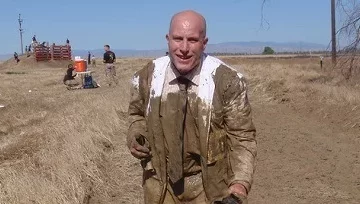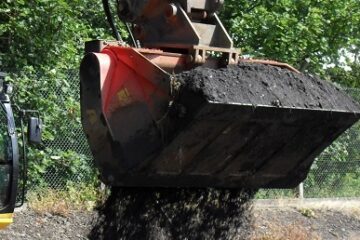The dreaded lingo and acronyms which can make a report confusing. We’ve put together a few of the most frequently used terms in the remediation industry below. We hope they’re helpful. We’ll update this regularly so feel free to add suggestions in the comments section and we’ll get back to you asap. Alternately send a quick e-mail to info@soilutions.co.uk.
Term Definition
Acute— Relates to short term significant effects and exposures.
Air Sparging— Injecting air into the soil and/or groundwater to flush contaminants and increase oxygen concentrations.
Bioaccumulation— The accumulation of contaminants in an organism.
Bioavailability— The availability of a contaminant e.g. a contaminant may be locked into soil and not readily ‘available’ to affect an impact.
Bioremediation— The breakdown of contaminants by natural (biological) processes.
Capping Layer— A layer which prevents contact with a contaminant e.g. a layer of clean soil over contaminated soil.
Carcinogen— A substance which can cause cancer.
Chronic— Relates to long term significant effects and exposures.
Clean-up— Same as cleaning up at home except in respect to contaminants it is generally called remediation.
Contaminant— A substance which is causing or may cause an adverse effect.
Cover System— A layer which prevents contact with a contaminant e.g. a layer of clean soil over contaminated soil.
Dermal— The exposure pathway of contact with your skin.
Dissolved Phase— The part of hydrocarbon contamination which has dissolved /partitioned into a body of water.
DNAPL— Dense Non-Aqueous Phase Liquid this is a liquid which doesn’t mix with water and is denser than water and so sinks. Common contaminants of this type are chlorinated solvents, creosote and mercury.
Exposure Pathway— The route by which a contaminant reaches a receptor, such as ingestion, inhalation or dermal contact for humans, runoff to surface waters or soil leaching to groundwater there are many pathways, these are examples and far from an exhaustive list.
Ex-situ— Removed from the original position. E.g. excavated soils.
Free Product / Free Phase— A term to describe hydrocarbon contamination which is present as a discrete substance rather than mixed with water or soil, commonly used to refer to LNAPL floating on a layer of water or visible at surface.
Geotechnical— To do with the physical and engineering properties of the ground.
Groundwater— A simple description for a relatively simple concept, this is the water which moves through the soil or rock under the ground.
Hazardous substance / waste— Solids, liquids or gases which can harm living organisms. Contaminated materials are not always hazardous!
Heavy Metals— A group of metal elements generally known to be dangerous to health or the environment e.g. mercury & zinc
Hydrocarbon— The main constituent of fuels and oils, derived from hydrogen and carbon.
Ingestion— The exposure pathway of eating or drinking a contaminant, particularly relevant when risk assessing for small children who like eating soil.
Inhalation— The exposure pathway of breathing in a contaminant either in the form or dust, vapour or in the case of asbestos, fibres.
Inorganic— Compounds which have no organic content, includes heavy metals.
In-situ— In the original position e.g. soils treated without being excavating, is termed in-situ remediation.
LNAPL— Light Non-Aqueous Phase Liquid ie a liquid which is less dense than water and does not mix with water and so floats. Common contaminants which fit this category are hydrocarbons such as kerosene, diesel and petrol.
Monitoring Installation— Sometimes called a monitoring well for obvious reasons this is a pipe down into the ground to allow the monitoring of ground gas and collection of water samples. Commonly constructed of lengths of plastic pipe in a range of diameters depending upon the intended use.
Organic— Compounds containing carbon and generally having derived from living matter.
Oxidation— In remediation terms as this one is quite complex, the addition of an oxygen molecule to a compound. For hydrocarbons this leads to breakdown to a less harmful compound.
PAH— Polycyclic Aromatic Hydrocarbons are a group of contaminants distinguished by a structure of linked aromatic (benzene) rings. They primarily arise from the incomplete combustion of a wide range of things but can also be found as contaminants in oils and a wide range of other hydrocarbon compounds. They are of concern because they are suspect carcinogens, mutagens and teratogens.
Pesticide— A chemical which is used to treat (ie kill or control) pests, either plants or animals.
Plume— An area of soil, water or air which is occupied by a contaminant which is migrating from a source.
PPB— Parts Per Billion is a way of measuring concentrations. 1 gram of a 1 ppb concentration compound would contain 1 billionth of a gram or 1×10-9 grams in every gram of that compound or 1µg/kg.
PPM— Parts Per Million unsurprisingly is a way of measuring concentrations. 1 gram of a 1 ppm concentration compound would contain 1 millionth of a gram or 1×10-6 grams in every gram of that compound, or 1 mg/kg.
Pump & Treat— Pumping water through a treatment system.
RA (Risk assessment)—Determination of a dangerous or harmful event.
Receptor— The thing which is impacted by an identified source of contamination. This can be humans, animals, plants, buildings and groundwater this is by no means an exhaustive list.
Rebound— Used to define the return of contamination in to groundwater following treatment.
Remediation— The removal of environmental risks.
Residual— Low levels of contamination remaining from remediation works. Could be assumed to be at levels which are no longer a risk.
Risk— Exposure to a dangerous or harmful event.
Soil Bore— Also commonly referred to as a Borehole this is a hole drilled down into the ground to investigate ground conditions, collect samples and instal monitoring installations.
Source— The point or area from which contamination can spread, i.e. the material which is the root of all the problems.
Stabilisation— A process of ‘locking’ contaminants into soil so that they are no longer a risk.
SVE— Soil Vapour Extraction, the process of sucking gases through/from soils.
SVOC— Semi Volatile Organic Compound, a wide range of organic contaminants which includes PAHs amongst other things.
Waste— Tricky one in just a few words, something which does not have a use.
Water table— The top level of groundwater.
VOCs— Volatile Organic Compounds, organic compounds which are readily present as or become vapour at normal temperature and atmospheric conditions, the list of compounds in this group is far too numerous to list here.







Leave a Reply